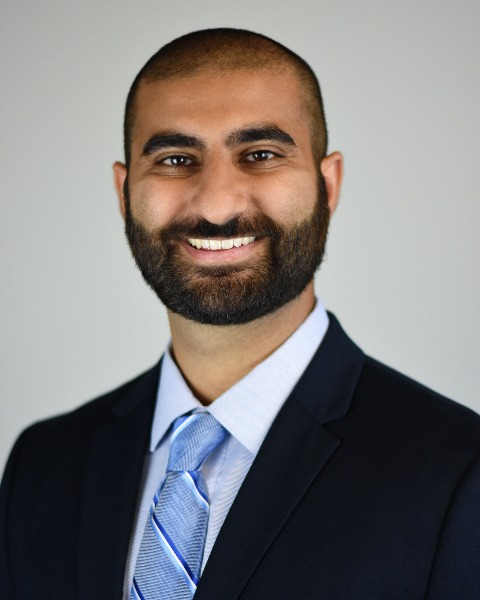Back
Endoscopy Video Forum
Annual Scientific Meeting
Session: Symposium 2C: 10th Annual Endoscopy Video Forum
V2 - Endoscopic Suture Repair of a Transmural Esophageal Perforation
Monday, October 24, 2022
5:00 PM – 5:10 PM ET
Location: Richardson Ballroom AB

Munraj Singh, MD (he/him/his)
Louisiana State University Health Sciences Center
New Orleans, LA
Presenting Author - Endoscopy Video Forum(s)
Munraj Singh, MD, Catherine Hudson, MD, MPH
Louisiana State University Health Sciences Center, New Orleans, LA
Introduction: Iatrogenic esophageal perforations during endoscopic procedures are associated with considerable morbidity and mortality. Traditional management of large esophageal perforations included an aggressive approach involving surgery, but despite advances in techniques, postoperative complications remain high. Conservative management with endoscopic suturing and stenting has drastically improved patient outcomes. Herein, we present a patient with a guidewire associated 12 cm full thickness esophageal perforation that was successfully repaired by endoscopic suturing and stent placement.
Case Description/Methods: A 60-year-old female with pmhx of GERD and chronic dysphagia presented s/p outpatient EGD empiric guidewire assisted dilation to 54Fr that was complicated by an approximately 12cm full thickness esophageal tear/perforation and pneumomediastinum. On endoscopic evaluation a large esophageal perforation was found 40 cm from incisors. A total of 4 endoscopic sutures were used to approximate the edges of the perforation in an interrupted fashion. A 15 cm fully covered stent was then endoscopically deployed over the defect with 2 sutures used for stent fixation. Following the procedure, CT esophagram showed absence of an esophageal leak. She underwent repeat EGD 2 weeks later for stent removal which showed adequate healing of the esophagus and no evidence of ongoing defect or perforation.
Discussion: Endoscopic suturing was first approved by the USDA in 1998 and its uses have expanded to the repair of fistulas, perforations and anastomotic leaks. The closure technique involves approximating the defect edges using continuous and interrupted sutures, via an endoscopic suturing device. The size of the perforation limits other endoscopic interventions including over the scope clips (OTSC) which are effective in closing perforations up to 1-2 cm in size. Sharaiha et al. reported the successful closure of esophageal perforations in 13 patients using endoscopic suturing. However, the defect size ranged from 25 to 50 mm in length, much smaller than the case we present which included a 12 cm transmural defect. Further, endoscopic suturing alone is not as effective in perforation closure when compared to the addition of stent placement.
Disclosures:
Munraj Singh, MD, Catherine Hudson, MD, MPH, V2, Endoscopic Suture Repair of a Transmural Esophageal Perforation, ACG 2022 Annual Scientific Meeting Abstracts. Charlotte, NC: American College of Gastroenterology.
Louisiana State University Health Sciences Center, New Orleans, LA
Introduction: Iatrogenic esophageal perforations during endoscopic procedures are associated with considerable morbidity and mortality. Traditional management of large esophageal perforations included an aggressive approach involving surgery, but despite advances in techniques, postoperative complications remain high. Conservative management with endoscopic suturing and stenting has drastically improved patient outcomes. Herein, we present a patient with a guidewire associated 12 cm full thickness esophageal perforation that was successfully repaired by endoscopic suturing and stent placement.
Case Description/Methods: A 60-year-old female with pmhx of GERD and chronic dysphagia presented s/p outpatient EGD empiric guidewire assisted dilation to 54Fr that was complicated by an approximately 12cm full thickness esophageal tear/perforation and pneumomediastinum. On endoscopic evaluation a large esophageal perforation was found 40 cm from incisors. A total of 4 endoscopic sutures were used to approximate the edges of the perforation in an interrupted fashion. A 15 cm fully covered stent was then endoscopically deployed over the defect with 2 sutures used for stent fixation. Following the procedure, CT esophagram showed absence of an esophageal leak. She underwent repeat EGD 2 weeks later for stent removal which showed adequate healing of the esophagus and no evidence of ongoing defect or perforation.
Discussion: Endoscopic suturing was first approved by the USDA in 1998 and its uses have expanded to the repair of fistulas, perforations and anastomotic leaks. The closure technique involves approximating the defect edges using continuous and interrupted sutures, via an endoscopic suturing device. The size of the perforation limits other endoscopic interventions including over the scope clips (OTSC) which are effective in closing perforations up to 1-2 cm in size. Sharaiha et al. reported the successful closure of esophageal perforations in 13 patients using endoscopic suturing. However, the defect size ranged from 25 to 50 mm in length, much smaller than the case we present which included a 12 cm transmural defect. Further, endoscopic suturing alone is not as effective in perforation closure when compared to the addition of stent placement.
Disclosures:
Munraj Singh indicated no relevant financial relationships.
Catherine Hudson indicated no relevant financial relationships.
Munraj Singh, MD, Catherine Hudson, MD, MPH, V2, Endoscopic Suture Repair of a Transmural Esophageal Perforation, ACG 2022 Annual Scientific Meeting Abstracts. Charlotte, NC: American College of Gastroenterology.

